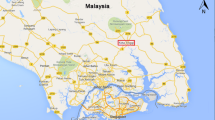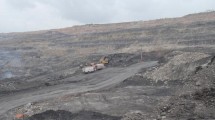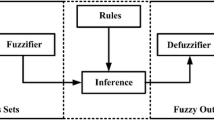Abstract
The aim of this paper is to propose three predictive models namely empirical, artificial neural network (ANN), and adaptive neuro-fuzzy inference system (ANFIS) for prediction of ground vibration produced by blasting operations conducted in Gol-E-Gohar Iron mine, Iran. In this way, 115 operations were precisely monitored and related parameters of blasting were measured. Furthermore, maximum charge per delay and the distance from the blast-face were set and applied to construct the ground vibration predictive models. By assigning all data sets into training and testing, many ANFIS and ANN models were constructed. The results revealed that the proposed ANFIS model can estimate ground vibrations more accurately than other developed models. Root-mean-square error value of 4.644, for testing data set, shows superiority of the ANFIS predictive system in predicting ground vibration while they were achieved as 7.522 and 10.689 for ANN and empirical models, respectively.









Similar content being viewed by others
References
Armaghani DJ, Mohamad ET, Hajihassani M, Yagiz S, Motaghedi H (2015a) Application of several non-linear prediction tools for estimating uniaxial compressive strength of granitic rocks and comparison of their performances. Eng Comput. doi:10.1007/s00366-015-0410-5
Armaghani DJ, Hajihassani M, Sohaei H, Mohamad ET, Marto A, Motaghedi H, Moghaddam MR (2015b) Neuro-fuzzy technique to predict air-overpressure induced by blasting. Arab J Geosci. doi:10.1007/s12517-015-1984-3
Ataei M, Kamali M (2012) Prediction of blast-induced vibration by adaptive neuro-fuzzy inference system in Karoun 3 power plant and dam. J Vib Control. doi:10.1177/1077546312444769
Bureau of Indian Standard (1973) Criteria for safety and design of structures subjected to underground blast. ISI Bull IS-6922
Demuth H, Beale M (2000) Neural network toolbox user’s guide version 4. The Math Works, USA
Demuth H, Beale M, Hagan M (2009) MATLAB version 7.14.0.739; neural network toolbox for use with Matlab. The Mathworks
Dreyfus G (2005) Neural networks: methodology and application. Springer, Berlin
Duvall WI, Petkof B (1959) Spherical propagation of explosion-generated strain pulses in rock. U.S. Dept. of the Interior, Bureau of Mines, Washington
Ebrahimi E, Monjezi M, Khalesi MR, Armaghani DJ (2015) Prediction and optimization of back-break and rock fragmentation using an artificial neural network and a bee colony algorithm. Bull Eng Geol Environ. doi:10.1007/s10064-015-0720-2
Faradonbeh RS, Armaghani DJ, Majid MA, Tahir MM, Murlidhar BR, Monjezi M, Wong HM (2016) Prediction of ground vibration due to quarry blasting based on gene expression programming: a new model for peak particle velocity prediction. Int J Environ Sci Technol. doi:10.1007/s13762-016-0979-2
Fisne A, Kuzu C, Hüdaverdi T (2011) Prediction of environmental impacts of quarry blasting operation using fuzzy logic. Environ Monit Assess 174:461–470
Ghasemi E, Sari M, Ataei M (2012) Development of an empirical model for predicting the effects of controllable blasting parameters on flyrock distance in surface mines. Int J Rock Mech Min Sci 52:163–170
Ghasemi E, Ataei M, Hashemolhosseini H (2013) Development of a fuzzy model for predicting ground vibration caused by rock blasting in surface mining. J Vib Control 19(5):755–770
Ghasemi E, Amini H, Ataei M, Khalokakaei R (2014) Application of artificial intelligence techniques for predicting the flyrock distance caused by blasting operation. Arab J Geosci 7(1):193–202
Gokceoglu C, Yesilnacar E, Sonmez H, Kayabasi A (2004) A neuro-fuzzy model for modulus of deformation of jointed rock masses. Comput Geotech 31:375–383
Grima MA, Bruines PA, Verhoef PNW (2000) Modeling tunnel boring machine performance by neuro-fuzzy methods. Tunn Undergr Sp Technol 15(3):259–269
Hasanipanah M, Monjezi M, Shahnazar A, Armaghani DJ, Farazmand A (2015) Feasibility of indirect determination of blast induced ground vibration based on support vector machine. Measurement 75:289–297
Haykin S (1999) Neural networks, 2nd edn. Prentice-Hall, Englewood Cliffs
Hecht-Nielsen R (1987) Kolmogorov’s mapping neural network existence theorem. In: Proceedings of the first IEEE international conference on neural networks, San Diego, CA, USA, pp 11–14
Hornik K, Stinchcombe M, White H (1989) Multilayer feedforward networks are universal approximators. Neural Netw 2:359–366
Hudaverdi T (2012) Application of multivariate analysis for prediction of blast-induced ground vibrations. Soil Dyn Earthq Eng 43:300–308
Inc SPSS (2007) SPSS for windows (version 160). SPSS Inc, Chicago
Iphar M, Yavuz M, Ak H (2008) Prediction of ground vibrations resulting from the blasting operations in an open-pit mine by adaptive neurofuzzy inference system. Environ Geol 56:97–107
Jang RJS (1993) ANFIS: adaptive-network-based fuzzy inference system. IEEE Trans Syst Man Cybern 23:665–685
Jin Y, Jiang J (1999) Techniques in neural-network based fuzzy system identification and their application to control of complex systems. In: Leondes CT (ed) Fuzzy theory systems, techniques and applications, vol 1, chap 5. Academic Press, San Diego, CA, pp 112–128
Kaastra I, Boyd M (1996) Designing a neural network for forecasting financial and economic time series. Neurocomputing 10:215–236
Kahriman A (2002) Analysis of ground vibrations caused by bench blasting at can open-pit lignite mine in Turkey. Environ Earth Sci 41:653–661
Kanellopoulas I, Wilkinson GG (1997) Strategies and best practice for neural network image classification. Int J Remote Sens 18:711–725
Khamesi H, Torabi S, Mirzaei-Nasirabad H, Ghadiri Z (2015) Improving the performance of intelligent back analysis for tunneling using optimized fuzzy systems: case study of the Karaj Subway Line 2 in Iran. J Comput Civ Eng 29(6):05014010
Khandelwal M, Kankar PK (2011) Prediction of blast-induced air overpressure using support vector machine. Arab J Geosci 4:427–433
Khandelwal M, Singh TN (2006) Prediction of blast induced ground vibrations and frequency in opencast mine: a neural network approach. J Sound Vib 289:711–725
Khandelwal M, Singh TN (2007) Evaluation of blasting induced ground vibration predictors. Soil Dyn Earthq Eng 27:116–125
Khandelwal M, Singh TN (2009) Prediction of blast-induced ground vibration using artificial neural network. Int J Rock Mech Min Sci 46:1214–1222
Khandelwal M, Kumar DL, Yellishetty M (2011) Application of soft computing to predict blast-induced ground vibration. Eng Comput 27(2):117–125
Laman M, Uncuoglu E (2009) Prediction of the moment capacity of short pier foundations in clay using the neural networks. Kuwait J Sci Eng 36:1–20
Looney CG (1996) Advances in feed-forward neural networks: demystifying knowledge acquiring black boxes. IEEE Trans Knowl Data Eng 8(2):211–226
Masters T (1994) Practical neural network recipes in C++. Academic Press, Boston
Mohamad ET, Noorani SA, Armaghani DJ, Saad R (2012) Simulation of blasting induced ground vibration by using artificial neural network. Electron J Geotech Eng 17:2571–2584
Mohamed MT (2011) Performance of fuzzy logic and artificial neural network in prediction of ground and air vibrations. Int J Rock Mech Min Sci 48(5):845–851
Monjezi M, Ghafurikalajahi M, Bahrami A (2011) Prediction of blastinduced ground vibration using artificial neural networks. Tunn Undergr Sp Technol 26:46–50
Nelson M, Illingworth WT (1990) A practical guide to neural nets. Addison-Wesley, Reading
Ozer U, Kahriman A, Aksoy M, Adiguzel D, Karadogan A (2008) The analysis of ground vibrations induced by bench blasting at Akyol quarry and practical blasting charts. Environ Geol 54:737–743
Paola JD (1994) Neural network classification of multispectral imagery. M.Sc. thesis, The University of Arizona, USA
Raina AK, Murthy VMSR, Soni AK (2014) Flyrock in bench blasting: a comprehensive review. Bull Eng Geol Environ. doi:10.1007/s10064-014-0588-6
Ripley BD (1993) Statistical aspects of neural networks. In: Barndoff-Neilsen OE, Jensen JL, Kendall WS (eds) Networks and chaos-statistical and probabilistic aspects. Chapman & Hall, London, pp 40–123
Sari M, Ghasemi E, Ataei M (2014) Stochastic modeling approach for the evaluation of backbreak due to blasting operations in open pit mines. Rock Mech Rock Eng 47(2):771–783
Sezer EA, Nefeslioglu HA, Gokceoglu C (2014) An assessment on producing synthetic samples by fuzzy C-means for limited number of data in prediction models. Appl Soft Comput 24:126–134
Shahin MA, Maier HR, Jaksa MB (2002) Predicting settlement of shallow foundations using neural networks. J Geotech Geoenviron Eng 128:785–793
Singh TN, Singh V (2005) An intelligent approach to prediction and control ground vibration in mines. Geotech Geol Eng 23:249–262
Singh R, Kainthola A, Singh TN (2012) Estimation of elastic constant of rocks using an ANFIS approach. Appl Soft Comput 12(1):40–45
Sonmez H, Gokceoglu C, Nefeslioglu HA, Kayabasi A (2006) Estimation of rock modulus: for intact rocks with an artificial neural network and for rock masses with a new empirical equation. Int J Rock Mech Min Sci 43:224–235
Swingler K (1996) Applying neural networks: a practical guide. Academic Press, New York
Verma AK, Singh TN (2011) Intelligent systems for ground vibration measurement: a comparative study. Eng Comput 27:225–233
Wang C (1994) A theory of generalization in learning machines with neural application. Ph.D. thesis, The University of Pennsylvania, USA
Yilmaz I, Yuksek G (2009) Prediction of the strength and elasticity modulus of gypsum using multiple regression, ANN, and ANFIS models. Int J Rock Mech Min Sci 46(4):803–810
Author information
Authors and Affiliations
Corresponding author
Rights and permissions
About this article
Cite this article
Ghoraba, S., Monjezi, M., Talebi, N. et al. Estimation of ground vibration produced by blasting operations through intelligent and empirical models. Environ Earth Sci 75, 1137 (2016). https://doi.org/10.1007/s12665-016-5961-2
Received:
Accepted:
Published:
DOI: https://doi.org/10.1007/s12665-016-5961-2




